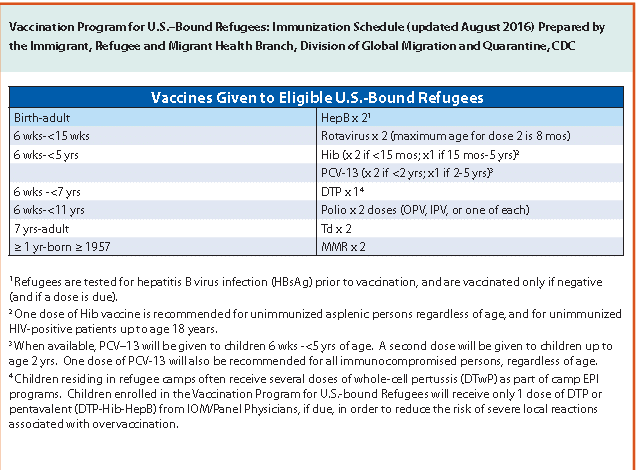Guest post by Janine Young, MD, FAAP
Associate Professor of Pediatrics, University of Colorado School of Medicine
Medical Director, Denver Health Refugee Clinic
Globally, we are witnessing the worst humanitarian crisis since World War II; there are over 65 million displaced people and, of these, less than one percent are referred by the United Nations High Commissioner for Refugees (UNHCR) for permanent resettlement to other countries. The maximum number of U.S. refugee arrival numbers is decided by an annual Presidential determination. In federal fiscal year 2016, the U.S. resettled 85,000 refugees; however, for this fiscal year, 2018, the arrival number was lowered to 45,000. In fiscal year 2017, the US resettled 51,392 refugees. This compares to Germany’s initiative in 2015 to resettle over 900,000 refugees, over half from Syria.
After a refugee is referred to the U.S. resettlement program from UNCHR, refugee applications are vetted by numerous federal agencies and include multiple background checks and finger-printing. The average length of time for an application to be approved for resettlement to the U.S. is 18-24 months but can vary by an applicant’s country of origin. Refugee status is a legal one, allowing for permanent resettlement to the U.S. Defined by international convention, refugees are individuals who, owing to a well-founded fear of being persecuted for reasons of race, religion, nationality, or membership of a particular social group or political opinion, are outside their country of nationality and are unable or unwilling to return to their home country.
Once refugees have been approved for resettlement to the U.S., they begin multiple medical evaluations. The medical evaluations are conducted by panel physicians appointed by the U.S. consulate or embassy or, in the case of large refugee movements, by the International Organization for Migration (IOM). These evaluations (which are performed in accordance with technical requirements and instructions from the Centers for Disease Control and Prevention’s Division of Global Migration and Quarantine) include initiation of immunizations. In most cases, first doses are given 3-6 months prior to departure, with the goal of providing at least 2 doses of each vaccine, depending on availability and logistics at each overseas refugee screening site (see table below). Live viral vaccines (e.g. MMR, varicella, rotavirus) are routinely not given less than 4 weeks prior to travel (except in certain outbreak settings) given the potential impact of live viral vaccines on other immunization initiation and testing interpretation upon arrival to the U.S.

At U.S. arrival, refugees are linked to a Domestic Medical Examination (screening) to test for clinical conditions that may be suggestive of underlying disorders. In Colorado, there are four sites that perform screening—Denver Health and Hospitals/Lowry, Metro Community Provider Network/Elmira, Sunrise Community Health/Montford, and Peak Vista Community Health Centers/Myron Stratton—all Federally Qualified Health Centers. Screening occurs within 90 days of arrival to the U.S., although the goal is to perform them within 30 days. At screening, administration of additional vaccines and/or testing for immunity occur.
Refugees are given standard information about the need to complete vaccination series during screening visits; however, completion of vaccination series often occurs in concert with efforts by Local Public Health Departments, School-Based Health Centers, school nurses and other primary care clinics.
There is much coordination that occurs at screening sites for new refugee arrivals. This involves efforts to assure that proof of historical vaccination is uploaded and that proof of immunity to vaccine preventable diseases is manually entered into the state database, Colorado Immunization Information System (CIIS). This ensures that refugees’ immunization history is easily accessible and reliable. Other efforts include assuring that catch-up vaccinations are administered at appropriate intervals, which is currently not calculated correctly for catch-up doses of IPV, Td and Tdap in many electronic medical record systems.
To learn more about refugee immunizations in Colorado, please visit the Colorado Refugee Immunization Provider Resource Hub. This website was developed by the members of the Colorado Refugee Immunization Taskforce as a centralized compilation of refugee immunization-related information, resources and guidelines to benefit providers who administer immunizations to refugees within the Colorado community.
For more information about catch-up vaccine schedules and correct intervals, please consult:
CDC Adult Immunization Schedule
CDC Child and Adolescent Schedule
CDC Immunization Phone App
Vaccination Program for U.S.-Bound Refugees, CDC
Guidelines for the U.S. Domestic Medical Examination for Newly Arriving Refugees, CDC
